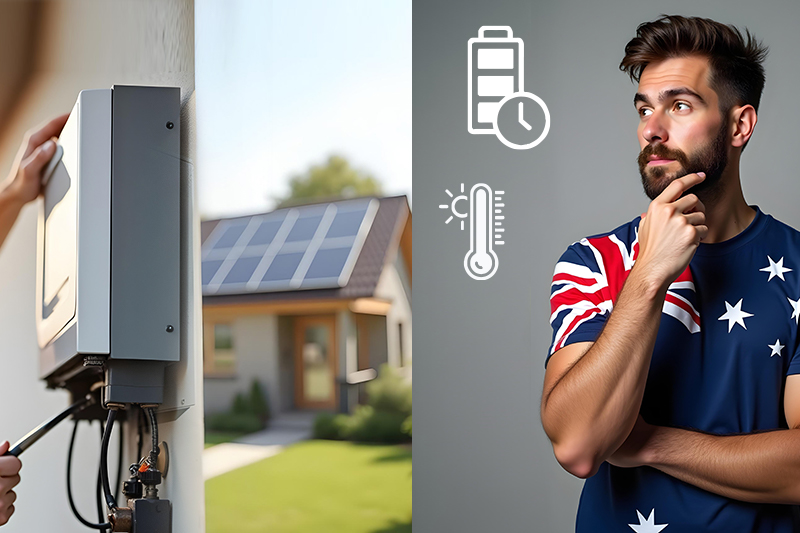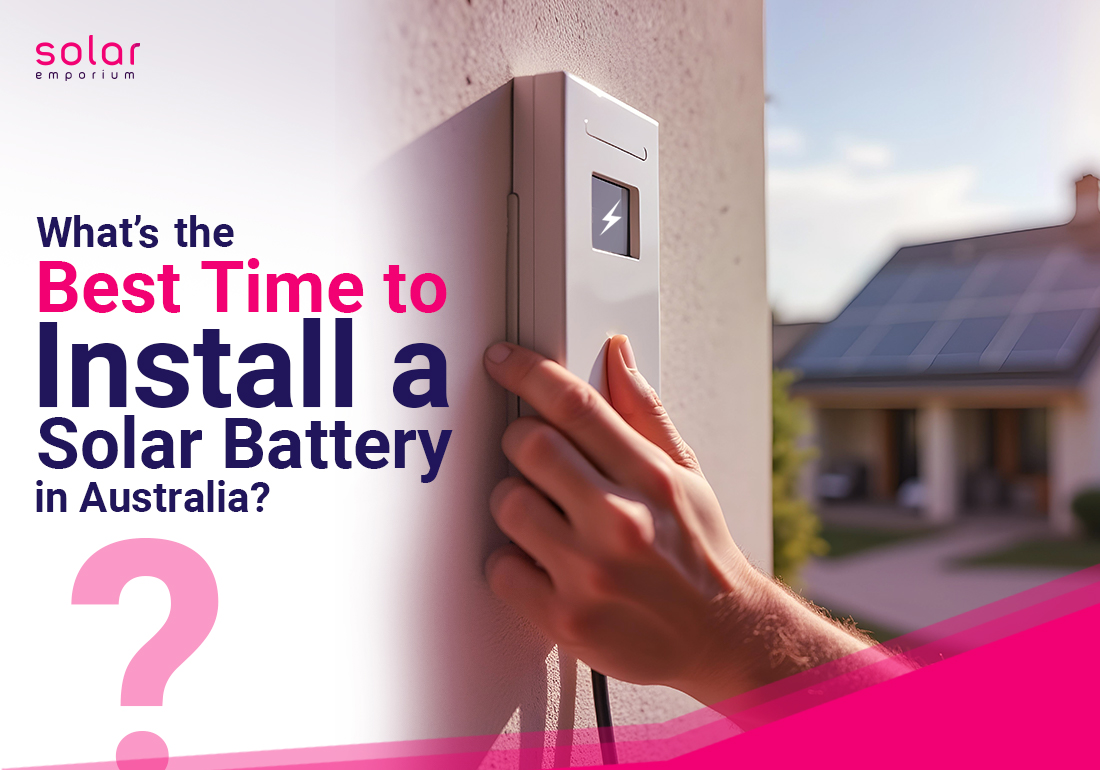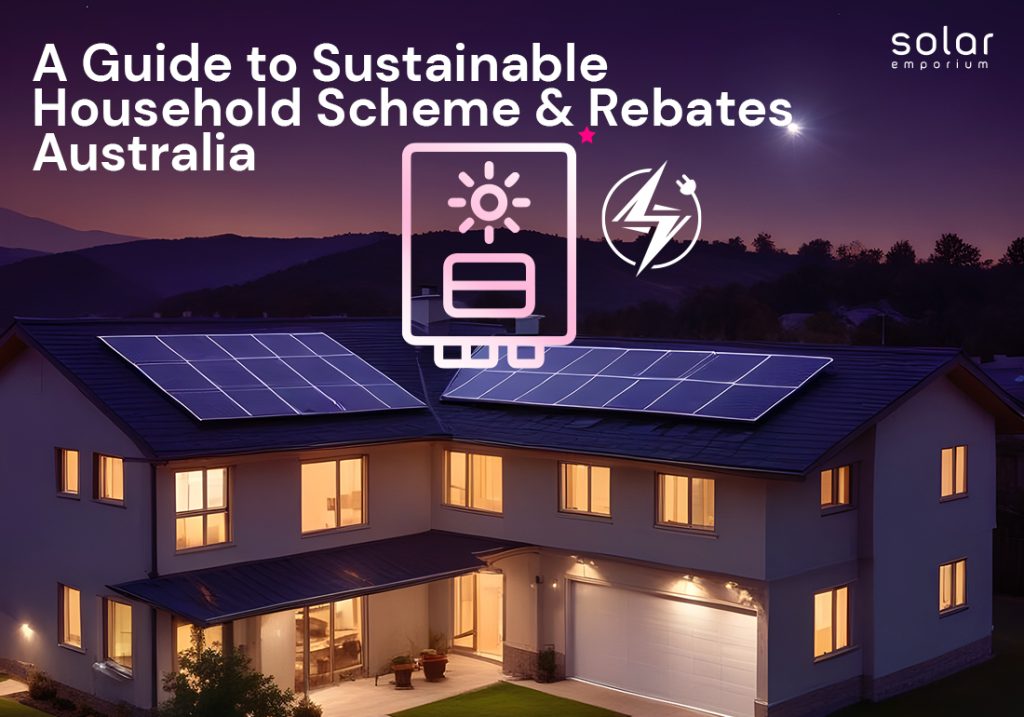When the world transits toward a future powered by renewable energy, solar batteries have become the spark that fuels this transformative revolution.
With these batteries, we don’t have to wait for the sun to shine bright every day. The energy revolution is upon us. We just harness the sun’s full power by storing it during peak hours and using it all day and night.
But there’s a catch! When purchasing solar panel systems in Australia, many people often get confused:
Is solar truly the key to a sustainable future? Is this the right time to install solar batteries?
Well, timing is everything when installing solar batteries! Installing them too early can prevent you from taking advantage of key incentives and rebates, while waiting too long can result in a significant loss in energy savings.
So, when? What’s the best time to install a solar battery in Australia?
Let’s find out more about it by reading this blog!
Power Up Your Home: A Deep Dive into Solar Battery Technology
While talking about solar batteries in Australia, these solar batteries provide reliable, uninterrupted electricity during nights, grid power outages, or any unexpected weather events.
These batteries store excess energy generated by the solar panels when the sun shines the brightest. The best part is that solar batteries empower homeowners to break free from the constant rise in electricity bills, reducing their dependence on the grid.
In general, two types of battery technology are widely used for solar battery manufacturing. The common types are lead-acid batteries and lithium-ion batteries.
However, lithium-ion batteries are the preferred choice for their extremely high efficiency, sleek outlook, tremendous depth of discharge rate, and extended lifespan.
Go Green and Save Big! Top 5 Benefits of Installing Solar Batteries in Australia
If you ever wonder why you should install a solar battery in Australia, just look at the clear benefits that are already unfolding.
From providing energy security to reducing our carbon footprint by eliminating the use of fossil fuels, solar batteries ensure environmental sustainability.
So, let’s have a look at the advantages of installing solar batteries in Australian households:
Greater Energy Independence
Solar batteries allow you to store and use your own power, making you less reliant on the grid or nonrenewable sources like coal, natural gas, or crude oil.
Reduced Electricity Bills
By storing energy during the day and using it at night, you can reduce your reliance on grid electricity during peak times, which often have higher rates.
Promotes Sustainability
Installing a solar battery is a step towards reducing your carbon footprint and contributing to Australia’s goal of net zero emissions by 2050. Using more solar energy reduces your reliance on fossil fuels, offering various environmental benefits.
Increased Property Value
Homes with solar power and battery storage systems are more attractive to buyers who are looking for energy efficiency and environmental sustainability.
Maximize Solar Investment
A solar battery helps you make the most of your solar panel system by allowing you to use all the energy you generate rather than losing excess power back to the grid.
Is Now the Right Time? | The Best Time to Install Solar Batteries for Australians

In a country like Australia, where the sun can be both a reliable friend and leave you with unpredictable challenges, the question isn’t just whether you should install a solar battery; it’s when you should make a move.
So, when is the perfect moment to make this transformative leap?
While the best time to install a solar battery can vary depending on your individual circumstances, there are a few key considerations that’ll help to make an easy decision:
- Installing a solar battery when energy prices are high will help you maximize savings by using stored energy during peak tariff periods.
- Take advantage of government Incentives or state and federal rebates by installing your system early in the financial year.
- Autumn and winter are off-peak periods for solar battery installations, offering shorter wait times and lower costs. So grab this opportunity and plan according to weather and seasonal demand.
- Ensure your solar battery is appropriately sized based on your energy needs and consumption patterns.
Basically, there are three main scenarios people follow for installing solar batteries:
- Most Australian homeowners like installing solar batteries along with their new solar system. It’s also cost-effective to install everything at once rather than repeatedly calling installers or spending extra on transportation.
- Some people prefer to wait 2 or 3 years before integrating batteries with their solar panel system so that they can take advantage of newer technology when available.
- If you already have a solar panel in Australia, you can upgrade it by installing a compatible battery like Tesla Powerwall or Alpha ESS with your existing system.
But remember, you might need to replace your solar inverter with a hybrid inverter or other equipment, which can be costly.
Australia’s Favourable Weather Conditions for Battery Installation.
Autumn and Spring (between September and November) present the best time for installing solar systems or batteries in Australia. They offer a range of advantages that make the installation process smoother and more efficient.
As the weather cools, drier conditions take over, providing a safer and more comfortable environment for installers to work on your home’s rooftop. The stable weather pattern ensures uninterrupted installations, reducing the risk of delays or complications.
In addition, autumn and spring offer a perfect temperature balance. With neither the extreme heat of summer nor the chill of winter, these seasons create a favorable environment for solar battery performance and installation.
The mild weather conditions make the process more comfortable for installers but also ensure that your system operates efficiently, harnessing the sun’s power and maximizing its energy production.
So, why wait for summer’s scorching heat or the winter’s unpredictability?
Autumn or spring can be your golden opportunity to harness the sun’s power more effectively. You must identify the best place to put your solar panels for minimal hassle and maximum battery efficiency.
How Australia’s Diverse Climate Conditions Impacting Battery Set-Ups?

From the tropical north to the temperate in south Australia, the country’s diverse weather patterns can significantly impact battery installation.
Battery installers must ensure that solar energy storage systems are equipped with features that can handle temperature extremes, especially when installing them on rooftops.
Let’s break down how each season affects battery performance and installation!
So, here’s how to fine-tune your solar battery for best performance in Australia’s ever-changing seasons:
Harness Australia’s Summer Heat: Maximize Solar Energy with a Smart Battery Setup
During summer, temperatures soar above 40°C in many regions, particularly northern Australia. This raises electricity prices and high grid demand, disrupting supply chain management.
Even though summer is a peak season for solar installations in Australia, the battery installation rate is slowest during summer. Why?
With the rise in battery demand, the wait times for installation also increase, making the process lengthy. Also, remember! Installation during summer should be done in shaded or ventilated areas to reduce battery overheating.
Turn Spring into Savings: Capture Australia’s Seasonal Sunshine with Longer and Brighter Days!
As mentioned before, spring provides an ideal environment for solar panels to generate more electricity with longer daylight hours, mild temperatures, and more sun exposure.
The weather is also ideal for installation crews. During this time, they can work efficiently without worrying about natural disasters like extreme storms, heavy snowfall, or heat waves.
Also, by preparing properly and installing the battery early, homeowners can start reaping the benefits of solar energy for the upcoming summer months and fight the high electricity demands.
Battling the Winter Cold: Why You Should Install Batteries During Winter?
Winter poses significant installation challenges, but did you know that scheduling installations during the off-peak season can result in quicker service? How?
Heavy snow and extreme cold often hinder installation, making the process more challenging. As a result, fewer installations occur in Australia during winter, ensuring your scheduled installation stays on track.
While prioritizing potential cost savings, winter can be a good option as installers offer many discounts due to low installation demand.
Installing solar batteries in the offseason ultimately provides peace of mind, as you’ll be prepared for energy cost savings for the upcoming summer.
Autumn Advantage: Preparing Your Solar Battery for the Seasonal Shift
As days shorten and temperatures cool, fall is still a great time for solar battery installations. With fewer installations, you can enjoy faster scheduling and potential savings on the installation and battery cost.
Scheduling early in autumn ensures your solar batteries and panels are ready to power you up before the first snowfall.
Battery integration can also be a great way to balance out energy consumption during the winter and summer months when the energy cost really spikes for heating and cooling.
This makes the overall energy costs much more manageable for Australians.
What Affects the Ideal Solar Battery Installation Time in Australia?
There are several important factors to consider when determining the ideal time to install a solar battery in Australia. Let’s take a closer look at each of them.
Energy Prices and Tariffs: The Influence of Electricity Rates
Australia has some of the highest electricity prices in the world, and this trend is expected to continue.
According to the Australian Energy Regulator (AER), the average electricity price for residential customers ranges from $0.22/kWh to $0.50/kWh, depending on the state and supplier.
Installing a solar battery can be a game-changer for those looking to reduce their electricity costs. The best time to install a solar battery is when electricity prices are high, as it allows you to store excess solar energy and use it when prices surge.
For example, in Australia, the energy demand peaks during evening hours, typically between 4 PM and 9 PM, increasing the electricity rates.
Therefore, using stored energy during these peak times can significantly reduce your monthly energy bills.
Government Incentives and Rebates: Taking Advantage of Financial Support
The Australian government offers several incentives to encourage the adoption of renewable energy technologies, including solar batteries.
The Small-scale Renewable Energy Scheme (SRES) provides financial rebates for eligible homeowners installing solar power systems and batteries.
Additionally, there are state-based incentives that vary depending on your location. For example, New South Wales and Victoria have introduced their own schemes offering rebates for solar battery installations.
To fully take advantage of these rebates, it’s a good idea to install your solar battery early in the financial year, between July to September, as funding for these schemes can run out towards the end of the year.
Seasonal Demand and Installation Timelines
In Australia, solar battery installation demand fluctuates depending on the season. Spring and summer tend to be the busiest times for solar installations due to favorable weather conditions and longer daylight hours.
So, if you’re considering installing a home battery during peak times, planning ahead is essential. The wait times for installation may be longer during the warmer months, and installation companies may have limited availability.
On the other hand, if you want to avoid delays and potentially get a better price, consider installing your solar battery in autumn or winter when demand is lower.
System Sizing and Battery Storage Capacity: Matching Your Needs
The right time to install a solar battery also depends on your energy use, your system’s performance, and your storage battery capacity needs. Solar batteries are generally sized to match your household’s energy consumption patterns.
So, what is the optimal time to use solar batteries in Aussie homes?
While maximizing savings, finding the perfect time to use your solar battery and using more of the electricity generated by your solar system can help you rely less on the grid and energy savings.
Aim to use electric appliances when your solar system produces the most power. Generally, the best times for Australians are:
- 10 am to 4 pm during Summer
- 11 am to 2 pm during Winter
For the most accurate times, you can also use a solar monitoring app to see when your system generates the most electricity.
If you use a lot of energy during these hours, you may need a larger battery to ensure you have enough stored power to cover your needs.
However, on sunny days, your solar panels may produce more energy than you can use. So you can perform all your energy-intensive tasks during that time to avoid high electric bills.
Take the Leap with Solar Emporium for Solar Battery Installation Today!

In summary, Australia’s climate presents both opportunities and challenges for battery storage.
The key to a successful installation is ensuring the battery system is equipped with features that handle temperature extremes, is appropriately located, and is paired with the right energy management system to optimize its performance year-round.
Ready to install a solar battery on your residential property? Request a free quote and start your renewable energy journey today with Solar Emporium!
However, you can also check out Solar Emporium’s guide to choose and install a solar battery for a better understanding.







